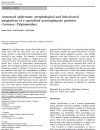Bibliografie
Armoured spiderman: morphological and behavioural adaptations of a specialised araneophagous predator (Araneae: Palpimanidae) 2011
- Autoři
- Jan Šobotník, prof. Mgr. Stanislav Pekár, Ph.D., prof. Mgr. Stano Pekár, Ph.D.
- Abstrakt
- In a predator–prey system where both intervenients come from the same taxon, one can expect a strong selection on behavioural and morphological traits involved in prey capture. For example, in specialised snake-eating snakes, the predator is unaffetced by the venom of the prey. We predicted that similar adaptations should have evolved in spider-eating (araneophagous) spiders. We investigated potential and actual prey of two Palpimanus spiders (P. gibbulus, P. orientalis) to support the prediction that these are araneophagous predators. Specific behavioural adaptations were investigated using a high-speed camera during staged encounters with prey, while morphological adaptations were investigated using electron microscopy. Both Palpimanus species captured a wide assortment of spider species from various guilds but also a few insect species. Analysis of the potential prey suggested that Palpimanus is a retreat-invading predator that actively searches for spiders that hide in a retreat. Behavioural capture adaptations include a slow, stealthy approach to the prey followed by a very fast attack. Morphological capture adaptations include scopulae on forelegs used in grabbing prey body parts, stout forelegs to hold the prey firmly, and an extremely thick cuticle all over the body preventing injury from a counter bite of the prey. Palpimanus overwhelmed prey that was more than 200% larger than itself. In trials with another araneophagous spider, Cyrba algerina (Salticidae), Palpimanus captured C. algerina in more than 90% of cases independent of the size ratio between the spiders. Evidence indicates that both Palpimanus species possesses remarkable adaptations that increase its efficiency in capturing spider prey.
Erratum to “Comparative study of the femoral organ in Zodarion spiders (Araneae: Zodariidae)” 2008
- Autoři
- Jan Šobotník, prof. Mgr. Stanislav Pekár, Ph.D., prof. Mgr. Stano Pekár, Ph.D.
- Abstrakt
- Erratum to ‘‘Comparative study of the femoral organ in Zodarion spiders (Araneae: Zodariidae)’’.
Comparative study of the femoral organ in Zodarion spiders (Araneae: Zodariidae). Arthropod Structure & Development 36: 105–112. 2007
- Autoři
- Jan Šobotník, prof. Mgr. Stanislav Pekár, Ph.D., prof. Mgr. Stano Pekár, Ph.D.
- Abstrakt
- The femoral organ of Zodarion spiders has not been investigated in detail yet. In this study we describe the external and internal structure of this organ. The organ is situated at the distal tip of the femora of all the legs during all developmental stages. The size of the organ (expressed as the number of hairs) increased with the ontogenetic development of Zodarion species. The organ was confirmed to occur in both sexes of all 47 Zodarion species examined. It is possibly present in all species of this genus. The size of the organ increased with the size of the species. A comparative anatomical study was performed in juveniles and adults of both sexes of Zodarion rubidum, and females of both Z. cyrenaicum and Z. jozefienae. The femoral organ represents an exocrine gland composed of a group of secretory cells located below the epidermis. Each gland cell is connected with the leg surface by a single duct. The ducts run in intercellular spaces and specialised canal cells are lacking.





